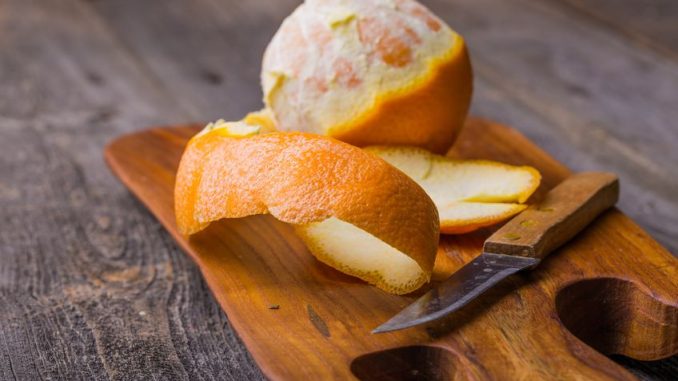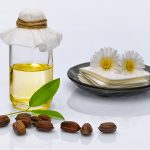
Hesperidin (3′ ,5,7-trihydroxy-4′methoxyflavonone-7-rhamnoglucoside) is an interesting compound. It’s found mainly in citrus fruits and has a particularly high concentration in sweet and bitter oranges.
History
The compound is a flavonoid and was first isolated by Leberton in 1828 from the albedo inside the peel of oranges. Albedo is the spongy white fleshy portion of skin inside the peel. It also occurs in the membrane or cytoplasm of the juice cell in a soluble form. Upon juice extraction, it usually comes into contact with the acid environment of the juice and is rendered insoluble. (Somogyi et al., 1996).
It was much later in 1874 that hesperidin was isolated from lemons by Pheffer. The isomer, neohesperidin was isolated from unripe sour oranges and has to date not been found in sweet orange. Its presence in sweet orange juice is regarded as a marker for adulteration with other citrus fruit juices such as grapefruit (Widmer, 2000; Sandhu and Minhas, 2006).
Hesperidin has been known as vitamin P and is a component of Chinese herbal medicines. In Europe and Australia, it is used to treat vascular disease. In the USA, it is combined with vitamin C in dietary supplements.
Neohesperidin is a bitter compound found in the bitter orange, Citrus aurantium. In grapefruit, naringin is a related compound and is also a marker for adulteration as with neohesperidin (Malik et al., 2014).
Hesperidin is the predominant flavonoid in lemons (Citrus limon) and sweet oranges, Citrus sinensis (Linn.) Osbeck. It is also found in other citrus fruit such as grapefruit (Citrus paradisi), mandarin, clementine and tangerine (Citrus reticulata). These fruits are characterised by the accumulation of high amounts of flavanone glycosides (1700-2800 mg naringin per kg grapefruit; 2700-6000 mg hesperidin per kg sweet orange) but with no flavan-3-ols.
In juice, hesperidin contributes about 10 per cent to 20 per cent of the juice cloud.
Amount Of Hesperidin In Foods
The approximate hesperidin content per 100 grams is recorded in the Phenol-Database, version 3.6:-
- 481 mg peppermint, dried
- 44 mg blood orange, pure juice
- 26 mg orange, pure juice
- 18 mg lemon, pure juice
- 14 mg lime, pure juice
- 1 mg grapefruit, pure juice
Hesperidin is also found in pommelo fruit
Solubility Of Hesperidin
Hesperidin is practically insoluble in water at acid pH but is soluble in alkaline solutions.
Extraction
Hesperidin is extracted from orange peel where the shredded peel is mixed thoroughly with a dilute lime solution to a final pH of 8.0 by mixing in a tank or screw conveyor for up to 30 minutes. The peel mix is squashed and pressed in a screw press, as used in the production of dried citrus peel for pectin manufacture. The alkaline liquid is screened and then filtered with the help of filter aid in a filter press (Arthey & Ashurst, 1995). The clear filtrate is acidified in tanks to below pH 3. The drop in pH leads to crystallisation of hesperidin which is then separated from the filtrate by centrifugation.
The crystals are often found coating various equipment surfaces as a white scale or film which breaks off as flakes. They are long and needle-like. Careful cleaning of equipment is needed as hesperidin readily fouls extraction equipment, especially filtration screens, used in essential oil production using citrus peels. Its presence contributes to a reduction in juice yield.
Medicinal Properties
Early studies are showing hesperidin has therapeutic benefits for treating particular diseases in the cardiovascular and neurological arenas.
The heart benefit aspect comes from a study of people who had suffered a heart attack. Those who had were given either hesperidin as a supplement or a placebo over a 4 week period. The researchers found that taking hesperidin reduced the levels of various markers associated with inflammation (Haidari et al., 2015).
One study showed hesperidin lowered cholesterol in rats and has significant antioxidant activity in vitro.
It has been touted as a weight reducing compound because it can inhibit fat accumulation in adipocytes. It may also help with diabetes management because it is known to improve glucose homeostasis and improve insulin sensitivity.
It is associated with the potential to relieve depression, calm inflammation, protect DNA from radiation damage, and slow the growth of several types of cancer including breast cancer.
Caution needs to be exercised in the interpretation of such studies.
Hesperidin And Diabetes
At the moment the research on diabetes management is not very conclusive. Most of the studies tend to focus on orange juice which would contain some hesperidin but in undefined quantities.
A trial with 10 healthy women showed early on that daily consumption of orange juice could lower blood sugar levels. The orange juice was also claimed to have a benefit on gut microflora and fauna. It appeared to increase the population of probiotic species such as Lactobacillus and Bifidobacteria. These are small scale studies but they may be a pointer to more significant and promising benefits (Lima et al., 2019).
Hesperidin And COVID-19
There are suggestions that hesperidin may have a role in warding off COVID-19.
The National Institutes of Health’s National Center of Biotechnology Information (NCBI) in the USA revealed it will check out the clinical efficacy of hesperidin against COVID-19 starting from December 2020.
The organisation has stated in a press report that:
“Hesperidin is a promising drug candidate for the prevention and treatment of COVID-19. Hesperidin interferes with viral entry through ACE2 receptors, improves the host cellular immunity, minimizes the release of inflammatory mediators and its mixture protects against venous thromboembolism.”
Hesperidin And Sport
Increasing evidence suggests it has benefits for sports people.
A Spanish cycling study looked at the chronic benefits of a variant called 2S-hesperidin supplementation. The study assessed supplementation using a branded compound called Cardiose (500mg).
References
Arthey, D., Ashurst, P.R. (1995) Fruit Processing. Springer.
Haidari F, Heybar H, Jalali MT, Engali KA, Helli B, Shirbeigi E. (2015) Hesperidin Supplementation Modulates Inflammatory Responses Following Myocardial Infarction. Journal of the American College of Nutrition. 34(3) pp. 205-211. doi:10.1080/07315724.2014.891269
Lima ACD, Cecatti C, Fidélix MP, Adorno MAT, Sakamoto IK, Cesar TB, Sivieri K. (2019) Effect of Daily Consumption of Orange Juice on the Levels of Blood Glucose, Lipids, and Gut Microbiota Metabolites: Controlled Clinical Trials. J Med Food. Feb;22(2) pp. 202-210. doi: 10.1089/jmf.2018.0080. Epub 2019 Jan 14. PMID: 30638420. (Article).
Malik, A., Erginkaya, Z., Ahmad, S. (2014) Food Processing: Strategies for Quality Assessment. Springer.
Somogyi, L. Barrett, D.M., Hui, Y.H. (1996) Processing Fruits. CRC
Revision: Additional research material added relating to diabetes, COVID-19 and sports.


Leave a Reply